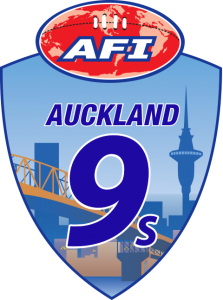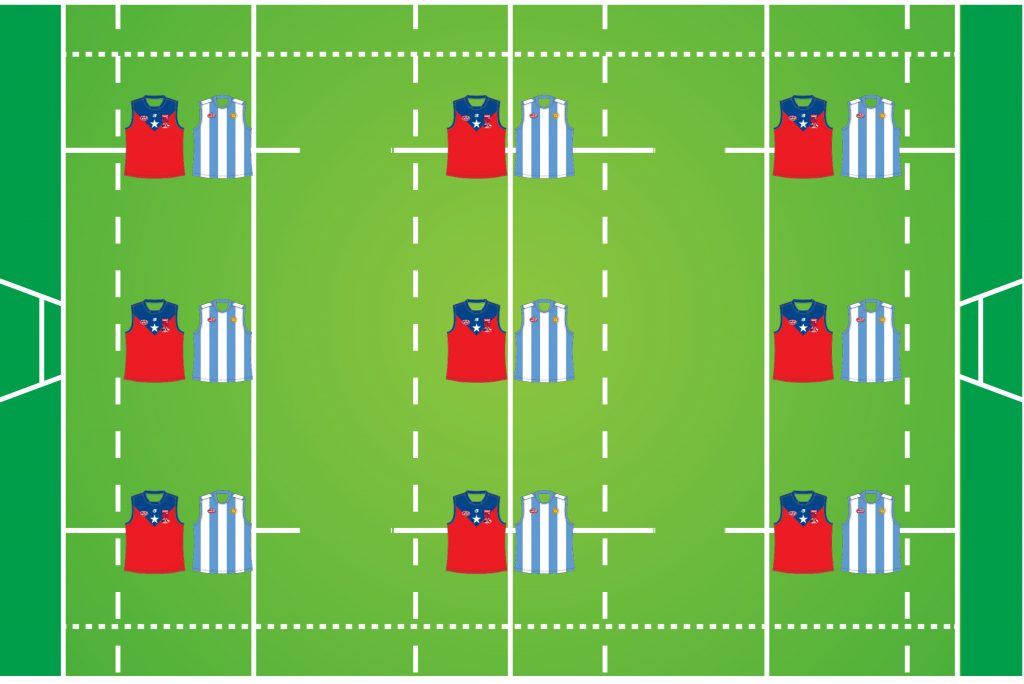
1. Playing Field
1.1 The Auckland 9s will be played on a full sized rugby field, using rugby posts as the goals. There are no behind posts.
1.2 A line known as the boundary line shall mark the boundary of the playing field.
1.3 The longer line shall be called the side line.
1.4 The shorter line shall be called the goal line.
2. Teams
2.1 Teams consist of 9 players on the field and a maximum of 6 reserves.
2.2 Interchange of players may take place at any time.
2.3 Teams consist of 3 forwards, 3 midfielders and 3 backs.
2.4 At the start of play and after each goal, the midfielders must line up in the centre of the playing field i.e. between the 40m lines.
2.5 At the start of play and after each goal, the forwards and backs must line up behind the 22 metre line.
2.6 Players must be in their respective zones prior to the jump ball, otherwise a free kick will be paid against the offending team. The free kick will be awarded in the centre of the field, to the opposition ruckman.
3. Playing Time
3.1 All matches consist of 2 x 15 minute halves, plus 3 minutes for half-time.
4. Start of Play
4.1 The game is started by a jump ball between two players in the centre of the playing field.
4.2 A player may not grab the ball at the jump ball and play on. They must attempt to knock or tap the ball to another player.
4.3 After a goal, the ball is taken back to the centre and restarted as in rule 4.1.
4.4 At each jump ball, either at the start of the game or after a goal, midfielders are not permitted to have a shot at goal. They must pass, or attempt to pass, the ball to a teammate via a kick. Once the ball touches a teammate or opponent, the ball is ‘live’ and a goal can be scored by any player on the field.
4.5 The purpose of rule 4.4 is to ensure that, on a rugby field, scoring does not become so easy that it dilutes the excitement of the game for both players and spectators.
5. Scoring
5.1 Goals are scored by kicking the ball through the posts, either under or over the crossbar.
5.2 If the ball hits or is touched by any player on the field, whether a member of the attacking or defending team, prior to passing through the goals, a goal shall not be scored.
5.3 If the ball hits any part of the posts and continues through the posts, it is a goal.
5.4 If the ball hits any part of the posts and comes back into the field of play, play will continue.
5.5 Goals must be scored from within the attacking team’s own half.
6. Missed Shot for Goal
6.1 After an unsuccessful shot at goal by the attacking team, a member of the defending team shall bring the ball back into play via a kick, from directly in front of the posts.
6.2 When kicking the ball back into play, the player with the ball cannot play on.
6.3 The player with the ball must kick the ball before the 5m line.
6.4 The man on the mark must be no closer than 10m from the player kicking the ball back into play.
6.5 When kicking the ball back into play, the player with the ball shall not be permitted to kick the ball beyond the 50 metre line.
6.6 If the ball is kicked beyond the 50 metre line, a free kick shall be awarded to a member of the opposing team. The free kick will be awarded in the centre of the field, with the player on the mark standing on the 50 metre line.
7. Out of Bounds (side line)
7.1 When the ball goes out of bounds by either foot or hand, anywhere along the side line, the nearest opponent shall kick (not handball) the ball back into play.
7.2 If there is doubt as to which team forced the ball out of bounds, the umpire shall throw the ball up.
7.3 No score will be allowed when kicked from an out of bounds free kick.
8. Corner Kicks – Deliberate Out of Bounds (goal line)
8.1 If a member of the attacking team knocks the ball over the goal line, a member of the defending team shall bring the ball back into play via a kick, from directly in front of the posts.
8.2 However, if a member of the defending team is deemed to have deliberately knocked the ball over the goal line, a free kick (corner kick) will result.
8.3 The corner kick will take place at the intersection of the goal line and side line i.e. the corner of the rugby field.
8.4 Opposition members must be no closer than 10 metres from the player taking the corner kick.
8.5 The player taking the corner kick has two options – to kick the ball to a teammate or to attempt a shot for goal.
8.6 As soon as the player taking the corner kick steps into the field of play, the umpire shall call play on.
9. Tackling
9.1 When a player is tackled by an opponent, they must dispose of the ball by handball or kick. If the player fails to dispose of the ball, possession will be awarded to the other team.
9.2 If a player has had prior opportunity to dispose of the ball when tackled, it is holding the ball and a turnover will occur.
9.3 Excessive tackling, such as driving or slinging an opponent, is not allowed.
9.4 If, in the opinion of the umpire, a tackle is deemed excessive, a free kick will be awarded against the tackler. A player may also be sent from the field.
9.5 At all times the focus of tackling shall be to win the ball, not deliberately injure an opponent.
10. Marking
10.1 Any player catching a ball directly from the kick of another player, provided it has traveled at least 10 metres, shall be awarded a mark.
10.2 If the ball is touched in flight, the umpire shall call ‘play on’ and a mark will not be awarded.
10.3 If a player is awarded a mark, they can play on immediately or they can stop and take a free kick.
10.4 If a player stops to take a free kick they cannot be tackled by an opponent.
10.5 Any player catching a ball directly from a handball shall not be awarded a mark i.e. play shall continue.
11. Bouncing the Ball
11.1 A player in possession must bounce the ball after running with it for 10 metres.
11.2 There is no limit as to how many bounces a player can take.
12. Kicking Off the Ground
12.1 A player is not permitted to deliberately kick the ball off the ground.
12.2 If a player makes contact with the ball with his foot during the course of play, and it is deemed accidental, the umpire shall call ‘play on’ and play shall continue.
12.3 For safety reasons, players are also not permitted to kick the ball in the air i.e. whilst the ball is not in possession by either team.
